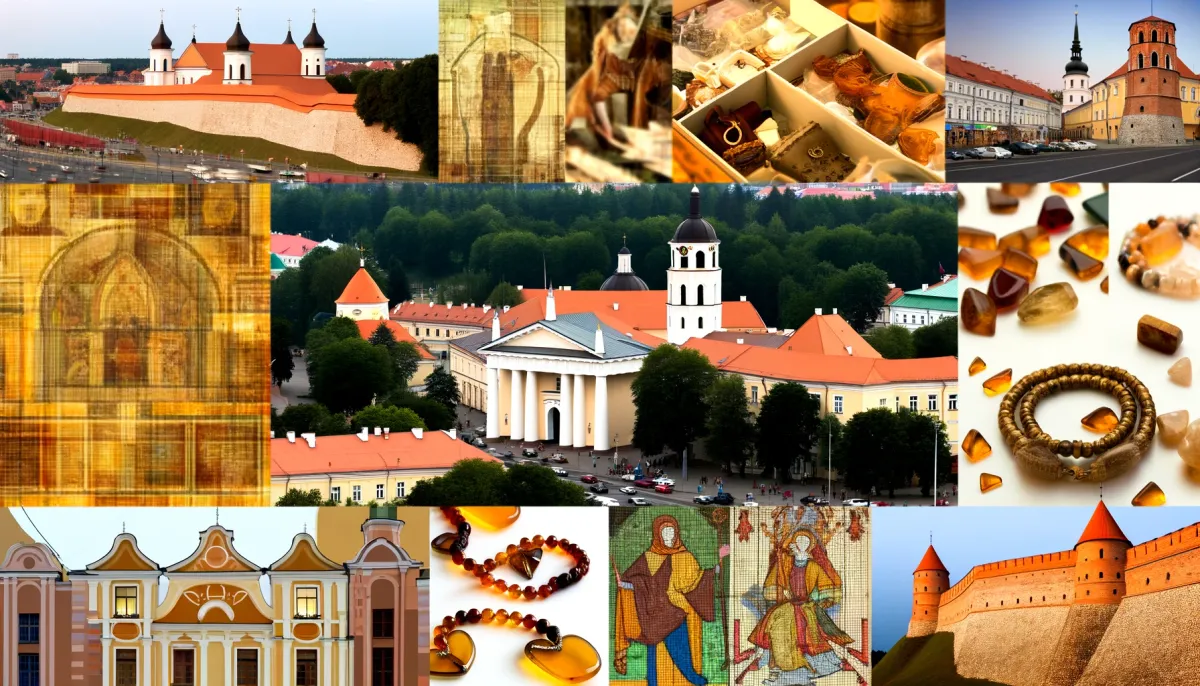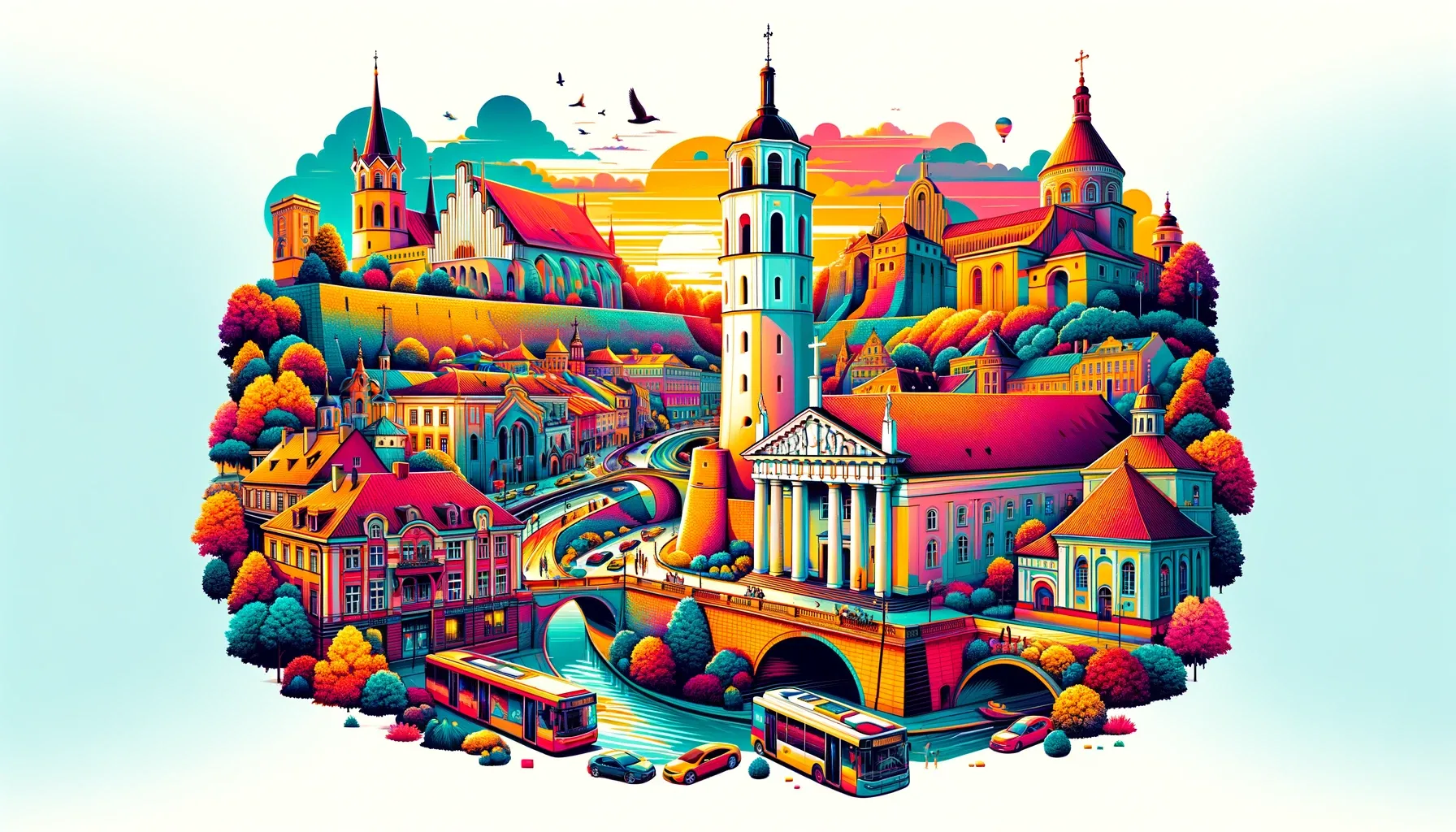Exploring Vilnius: A Comprehensive Guide to Lithuania's Charming Capital
Vilnius, the capital of Lithuania, is a city steeped in history, culture, and natural beauty.

Vilnius, the capital of Lithuania, is a city steeped in history, culture, and natural beauty. Nestled in the heart of Europe, Vilnius offers a unique blend of old-world charm and modern amenities, making it a popular destination for travelers from around the globe. In this section, we will explore the rich history and layout of this beautiful city.
A Brief History of Vilnius

Vilnius has a long and complex history, dating back to the 14th century when it was first established as the capital of the Grand Duchy of Lithuania. Over the centuries, the city has been influenced by a variety of cultures, including Polish, Russian, and German, giving it a rich and diverse heritage.
At the height of its power in the 15th and 16th centuries, the Grand Duchy of Lithuania was one of the most powerful states in Europe, and Vilnius was its thriving capital. The city was a center of trade, culture, and learning, attracting scholars, artists, and merchants from all over Europe.
However, the city's fortunes began to decline in the 17th century, when it was hit by a series of disasters, including the plague, fires, and wars. The city was occupied by foreign powers, including Russia and Poland, and its influence and prestige waned.
It was not until the 20th century, with the restoration of Lithuanian independence in 1918, that Vilnius began to regain its former status as a cultural and political center. However, the city's fortunes took another turn for the worse in World War II, when it was occupied by Nazi Germany and then by the Soviet Union.
Despite these challenges, Vilnius has emerged as a vibrant and modern city, with a rich cultural heritage and a thriving arts scene. Today, it is a popular destination for travelers seeking to explore its historic Old Town, beautiful parks and gardens, and lively nightlife.
Geography and Layout of the City
Vilnius is located in the southeastern part of Lithuania, in a hilly region known as Aukštaitija. The city covers an area of approximately 400 square kilometers and is home to a population of over 500,000 people.
The city is divided into several districts, each with its own unique character and charm. The Old Town, or Senamiestis, is the historic heart of the city and is home to many of its most famous landmarks, including the Gediminas' Tower, the Vilnius Cathedral, and the Palace of the Grand Dukes of Lithuania.
Surrounding the Old Town is the New Town, or Naujamiestis, which is home to many of the city's shops, restaurants, and hotels. The New Town is also home to several important landmarks, including the Vilnius University, the Church of St. Peter and St. Paul, and the Gate of Dawn.
Beyond the New Town, the city is surrounded by several large parks and gardens, including Vingis Park, which is the largest park in Vilnius and is home to a variety of sports facilities, walking trails, and outdoor concerts.
Top Tourist Attractions in Vilnius

Vilnius, the capital city of Lithuania, is a popular tourist destination with a rich history, stunning architecture, and beautiful natural scenery. Here are some of the top tourist attractions in Vilnius:
Vilnius Old Town
The Old Town, or Senamiestis, is the historic heart of Vilnius and a UNESCO World Heritage Site. It is home to many of the city's most famous landmarks, including winding cobblestone streets, charming courtyards, and stunning architecture. Visitors can explore the Old Town on foot and discover its many hidden gems.
Gediminas' Tower
Gediminas' Tower is a symbol of Vilnius and offers stunning views of the city. The tower is all that remains of the Upper Castle, a defensive structure built in the 13th century. Visitors can climb to the top of the tower for panoramic views of the Old Town and the surrounding countryside.
Vilnius Cathedral
The Vilnius Cathedral is a stunning example of neoclassical architecture and is one of the most important religious sites in Lithuania. The cathedral was originally built in the 14th century and has been rebuilt and renovated several times over the centuries. Visitors can explore the cathedral's ornate interior, which features stunning frescoes, sculptures, and other works of art.
Gate of Dawn
The Gate of Dawn is a historic gate in the Old Town of Vilnius and one of the most important religious sites in the city. The gate was built in the 16th century and features a beautiful chapel dedicated to the Virgin Mary. The Gate of Dawn is said to have miraculous powers and is a popular pilgrimage site for Catholics and other visitors.
The Palace of the Grand Dukes of Lithuania
The Palace of the Grand Dukes of Lithuania is a stunning example of Renaissance architecture and was the residence of the Grand Dukes of Lithuania in the 15th and 16th centuries. The palace was destroyed during World War II and has been rebuilt in recent years. Visitors can explore the palace's ornate halls, which feature stunning frescoes, tapestries, and other works of art.
Trakai Island Castle (Day Trip)
Trakai Island Castle is a stunning example of Gothic architecture and is located on an island in Lake Galvė, just a short drive from Vilnius. The castle was built in the 14th century and was the residence of the Grand Duke of Lithuania. Visitors can explore the castle's ornate halls, which feature stunning frescoes, tapestries, and other works of art. The castle is surrounded by beautiful gardens and is a popular spot for picnics and other outdoor activities.
Culture and Cuisine in Vilnius

Vilnius is a city with a rich cultural heritage and a vibrant arts scene. From its stunning architecture and historic landmarks to its museums, art galleries, and performing arts venues, there is no shortage of cultural attractions in Vilnius. The city is also home to a diverse and delicious culinary scene, with a wide variety of restaurants and cafes serving everything from traditional Lithuanian cuisine to international favorites.
Lithuanian Cuisine: What to Try
Lithuanian cuisine is hearty and flavorful, with a focus on locally sourced ingredients and traditional cooking methods. Some of the most popular dishes in Lithuania include:
- Cepelinai: Large potato dumplings filled with meat or cheese, served with sour cream.
- Šaltibarščiai: A cold beet soup, served with potatoes and hard-boiled eggs.
- Kugelis: A potato pudding, usually served with sour cream.
- Blynai: Thin pancakes, often filled with meat or cheese.
- Vėdarai: Blood sausage, usually served with potatoes and sauerkraut.
Visitors to Vilnius can find these and other traditional Lithuanian dishes at local restaurants and cafes, as well as at food markets and festivals.
Museums and Art Galleries in Vilnius
Vilnius is home to a wide variety of museums and art galleries, showcasing everything from ancient artifacts to contemporary works of art. Some of the most popular museums and galleries in Vilnius include:
- The National Museum of Lithuania: A large museum with a wide variety of exhibits, including ancient artifacts, historical documents, and contemporary art.
- The Vilnius Picture Gallery: A museum with a large collection of European art, including works by famous artists such as Leonardo da Vinci, Rembrandt, and Peter Paul Rubens.
- The Museum of Genocide Victims: A museum dedicated to the victims of Nazi and Soviet occupation in Lithuania.
- The Contemporary Art Centre: A museum and art gallery dedicated to contemporary art, with a focus on Lithuanian and Baltic artists.
Traditional Music and Dance
Lithuanian music and dance are an important part of the country's cultural heritage. Traditional Lithuanian music is characterized by its use of folk instruments, such as the kanklės (a type of zither) and the skudučiai (a type of pan flute). Traditional Lithuanian dances are lively and energetic, with a focus on folk traditions and storytelling.
Visitors to Vilnius can experience traditional Lithuanian music and dance at local festivals, concerts, and performances. The city is also home to several dance companies and music ensembles that specialize in traditional Lithuanian music and dance.
Practical Information for Visiting Vilnius

Getting to Vilnius
Vilnius is easily accessible by air, with direct flights from many major European cities. The city is served by Vilnius Airport, which is located approximately 6 kilometers from the city center. From the airport, travelers can take a taxi, bus, or shuttle service to their destination.
Travelers can also reach Vilnius by train or bus. The city has a modern and efficient public transportation system, with regular train and bus services to and from other parts of Lithuania and neighboring countries.
Getting Around Vilnius
Vilnius is a compact city and is easy to explore on foot. The Old Town, in particular, is best explored on foot, as many of its streets are too narrow for cars. For travelers who prefer not to walk, the city has a modern and efficient public transportation system, with buses, trolleybuses, and trams serving all parts of the city.
Taxis are also widely available in Vilnius and are a convenient way to get around the city. Fares are reasonable, and travelers can either hail a taxi on the street or book one in advance through a reputable taxi company.
Accommodations in Vilnius
Vilnius offers a wide range of accommodations to suit all budgets and travel styles. From luxury hotels and boutique guesthouses to budget-friendly hostels and vacation rentals, there is something for everyone in Vilnius.
Some of the most popular areas for travelers to stay in Vilnius include the Old Town, the New Town, and the surrounding suburbs. The Old Town is the most convenient location for sightseeing, while the New Town offers a wider range of restaurants, cafes, and nightlife options.
Best Time to Visit Vilnius
The best time to visit Vilnius is during the spring or fall when the weather is mild and there are fewer crowds. Summers in Vilnius can be hot and crowded, while winters can be cold and snowy.
Travelers who plan to visit Vilnius during the winter months should pack warm clothing and be prepared for potentially slippery conditions. The city is beautiful during the winter, with many Christmas markets and festive decorations.
Tips for Visiting Vilnius
Here are some tips to help travelers make the most of their visit to Vilnius:
- Dress appropriately for the weather, and be prepared for sudden temperature changes.
- Bring comfortable shoes, as many of the city's streets and sidewalks are made of cobblestones.
- Respect local customs and traditions, and dress modestly when visiting religious sites.
- Be aware of your surroundings, especially at night, and take precautions to ensure your safety.
- Learn a few basic words and phrases in Lithuanian, such as "hello," "goodbye," and "thank you."
- Try local foods and cuisines, and be adventurous when trying new things.
- Take the time to explore the city's hidden corners and off-the-beaten-path destinations.
By following these tips and being respectful of local customs and traditions, travelers can have a safe, enjoyable, and memorable trip to Vilnius.





